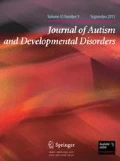Abstract
Few US estimates of the economic burden of autism spectrum disorders (ASD) are available and none provide estimates for 2015 and 2025. We forecast annual direct medical, direct non-medical, and productivity costs combined will be $268 billion (range $162–$367 billion; 0.884–2.009 % of GDP) for 2015 and $461 billion (range $276–$1011 billion; 0.982–3.600 % of GDP) for 2025. These 2015 figures are on a par with recent estimates for diabetes and attention deficit and hyperactivity disorder (ADHD) and exceed the costs of stroke and hypertension. If the prevalence of ASD continues to grow as it has in recent years, ASD costs will likely far exceed those of diabetes and ADHD by 2025.
References
Amendah, D., Grosse, S. D., et al. (2011). The economic costs of autism: A review. In D. Amaral, G. Dawson, & D. Geschwind (Eds.), Autism spectrum disorders. New York: Oxford University Press.
American Diabetes Association. (2013). Economic costs of diabetes in the U.S. in 2012. Diabetes Care, 36(4), 1033–1046.
Bodenheimer, T., & Grumback, K. (2012). Understanding health policy: A clinical approach. New York, NY: McGraw-Hill.
Buescher, A. V. S., Cidav, Z., Knapp, M., & Mandell, D. S. (2014). Costs of autism spectrum disorder in the United Kingdom and the United States of America. JAMA Pediatrics, 168(8), 721–728.
Centers for Disease Control and Prevention, Autism Spectrum Disorder, Data and Statistics. (2014). http://www.cdc.gov/ncbddd/autism/data.html. Accessed November 10, 2014.
Chasson, G. S., Harris, G. E., & Neely, W. J. (2007). Cost comparison of early intensive behavioral intervention and special eduction for children with autism. Journal of Child and Family Studies, 16(3), 401–413.
Congressional Budget Office. (2014). The economic outlook. (pp. 27–48) Table 2–1, p. 30. http://www.cbo.gov/sites/default/files/cbofiles/attachments/45010-breakout-Chapter2.pdf Accessed November 15, 2014
Doshi, J. A., Hodgkins, P., Kahle, J., et al. (2012). Economic activity of childhood and adult attention-deficit/hyperactivity disorder in the United States. Journal of the American Academy of Child and Adolescent Psychiatry, 51(10), 990–1002.
Dunbar, R. G. (2013). The Family and Medical Leave Act and the labor productivity of parents. Economic Letters. 118, 334–336.
Fombonne, E. (1999). The epidemiology of autism: A review. Psychological Medicine, 29(4), 769–786.
Ganz, M. (2006). The costs of autism. In S. Moldin & J. Rubenstein (Eds.), Understanding autism: From basic neuroscience to treatment. Boca Raton, FL: CRC Press.
Go, A. S., Mozaffarian, D., Roger, V. L., et al. (2014). Heart disease and stroke statistics—2014 update: A report from the American Heart Association. Circulation, 128, 1–267.
Knapp, M., & Buescher, A. (2014). Economic aspects of autism. In F. R. Volkmar, R. Paul, S. J. Rogers, & K. A. Pelphrey (Eds.), Handbook of autism and pervasive developmental disorders (4th ed., Vol. 2, pp. 1089–1106).
Knapp, M., Romeo, R., & Beecham, J. (2009). Economic cost of autism in the UK. Autism, 13, 317–336.
Mavranezouli, I., Megnin-Viggars, O., Cheema, N., Howlin, P., Baron-Cohen, S., & Pilling, S. (2014). The cost-effectiveness of support employment for adults with autism in the United Kingdom. Autism, 18(8), 975–984.
McMahon, J., Cullinan, V. (2014). Education programmes for young children with autism spectrum disorder: An evaluation framework. Research in Developmental Disabilities, 35(12), 3689–3697.
Motiwala, S. S., Gupta, S., Lilly, M. B., Ungar, W. J., & Coyte, P. C. (2006). The cost-effectiveness of expanding intensive behavioural intervention to all autistic children in Ontario. Healthcare Policy, 1(2), 135–151.
Office of the Actuary in the Centers for Medicare and Medicaid Services. (2014). NHE Projections 2013–2023—Tables, Table 1. http://www.cms.gov/Research-Statistics-Data-and-Systems/Statistics-Trends-and-Reports/NationalHealthExpendData/NationalHealthAccountsProjected.html. Accessed December 1, 2014
Penner, M., Rayar, M., Bashir, N., et al. (2015). Cost-effectiveness analysis comparing pre-diagnosis autism spectrum disorder (ASD)-targeted intervention with Ontario’s autism intervention program. Journal of Autism and Developmental Disorders,. doi:10.1007/s10803-015-2447-0.
Sisko, A. M., Keehan, S. P., Cuckler, G. A., Madison, A. J., Smith, S. D., Wolfe, C. J., et al. (2014). National health expenditure projections, 2013–23: Faster growth expected with expanded coverage and improving economy. Health Affairs, 33(10), 1841–1850.
US Census Projections. (2014). http://www.census.gov/population/projections/Accessed November 24, 2014.
Acknowledgments
First author acknowledges partial support from Autism Speaks (7636) and the National Institute for Occupational Safety and Health (U54OH007550).
Author contribution
Both authors contributed to the inception, design, writing, calculations, and organization of the research and manuscript.
Author information
Authors and Affiliations
Corresponding author
Electronic supplementary material
Below is the link to the electronic supplementary material.
Rights and permissions
About this article
Cite this article
Leigh, J.P., Du, J. Brief Report: Forecasting the Economic Burden of Autism in 2015 and 2025 in the United States. J Autism Dev Disord 45, 4135–4139 (2015). https://doi.org/10.1007/s10803-015-2521-7
Published:
Issue Date:
DOI: https://doi.org/10.1007/s10803-015-2521-7

